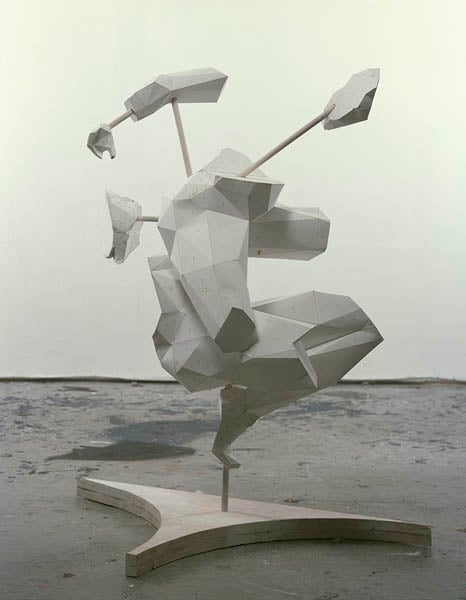
© » KADIST
Nazgol Ansarinia
In the early 2000s, as urban redevelopment accelerated and intense construction significantly diminished public space in Tehran, state-funded murals began to represent imaginary landscapes on building facades. The municipality of Tehran uses such pictorial representation to to exert influence over and come to terms with the flow of communal desire. The protrusion of the unreal onto the real interrupts the values, independence, and functionality of one over the other.

© » KADIST
Benoît Maire
The series Clouds paintings by Benoît Maire features oil on canvas works in varying format, in which the artist depicts clouds, using a variety of tools, including a spray gun, paintbrush, or palette knife. The cloud motif in this series of paintings questions the limits of abstraction by playing with the concept of pareidolia—a psychological phenomenon by which we recognize familiar shapes in landscapes, clouds, or ink stains. Through his careful composition and use of pentimenti, Maire invites the viewer to project their imagination onto these colorful clouds.

© » KADIST
Bobo
Simon & Gus by Bobo is a binaural and fantastical artwork that tells the story of a sea steading maker-hobbyist as told from the perspective of an arduino board, and a mars dwelling stop motion animator as told from the perspective of a stop motion armature. The stop motion animator attends an artist residency on the red planet, and eventually sets out to start his own artist colony (a martian animation studio) with stupefying hubris. The result has disastrous consequences, with the martian ghosts eventually swallowing his soul, and his armature gaining full access to the animator’s motor skills and control of his ability to move.

© » KADIST
Jazmín López
Shot on 35mm in two simply framed shots, Jazmín López’s Juego Vivo captures children at play, mixing imagination, reality, innocence, and violence. Set within a lush, green forest, we see first several children come into the frame, walking towards us, as a disembodied voice counts off “Tres…cuatro…cinco…” A game of hide and seek is at hand, and sounds of the girl counting are met with scattering children. In the first shot, while everyone else disperses, one boy advances steadily toward the camera, holding a scavenged stick in his hands, wielding it like a gun.

© » KADIST
Masaya Chiba
Fairy #2 (2011) depicts a surreal scene of roughly assembled household ephemera, potted plants, and a faintly visible figure rendered in thin red line. The picture shows a grouping of tables and stools arranged in a dense cluster. A collection of objects, all brown or burlap-hued, cover their surfaces: ceramic pots, wooden planks, roughly geometric wooden sculptures, and even a small figure that perches precariously atop of miniature cube alongside a forked wood finish form.
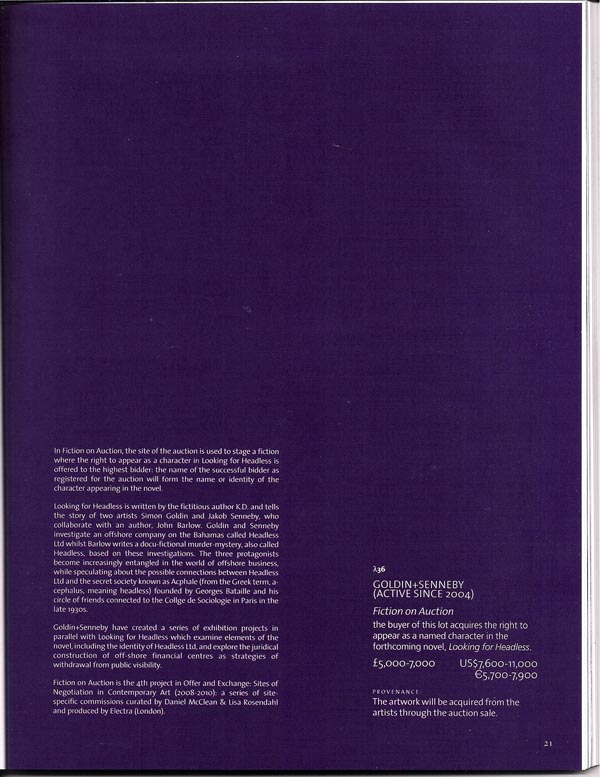
© » KADIST
Goldin+Senneby
In Fiction on Auction , the site of the auction is used to stage a fiction where the right to appear as character in Looking for Headless is offered to the highest bidder: the name of the successful biddder as registered for the auction will form the name or identity of the character appearing in the novel. Looking for Headless is written by the fictitious author K. D and tells the story of two artists Simon Goldin and Jakob Senneby who collaborate with an author, John Barlow. Goldin and Senneby investigate an offshore company on the Bahamas called Headless Ltd whilst Barlow writes a docu-fictional murder-mystery, also called Headless, based on these investigations.

© » KADIST
Toby Ziegler
The Fifth Quarter might have taken its mysterious inspiration from the eponymous Stephen King story collated into the Nightmares & Dreamscapes collection. Various vanishing points and interior perspectives, like in another painting dated the same year called Continental Breakfast , create a complex matrix in which motifs, shadowy or geometric forms coexist to further confuse the map of this space. A disturbing yet alluring virtual reality composed of a medley of seemingly abstract designs is depicted through digital and painterly means.

© » KADIST
Julius Koller
Drawing & Print (Drawing & Print)
Anti-Happening refers to Koller’s 1965 manifesto, ‘Anti-Happening (System of Subjective Objectivity)’. In opposition to the notion of a ‘happening’ as a way of actualising group identity, in his manifesto, Koller stated that his concept of the ‘anti-happening’ aimed at a ‘cultural reshaping of the subject, at awareness, at the surroundings and the real world’ [i] . Unlike happenings, these actions do not involve the staging of psychologically expressive performances.
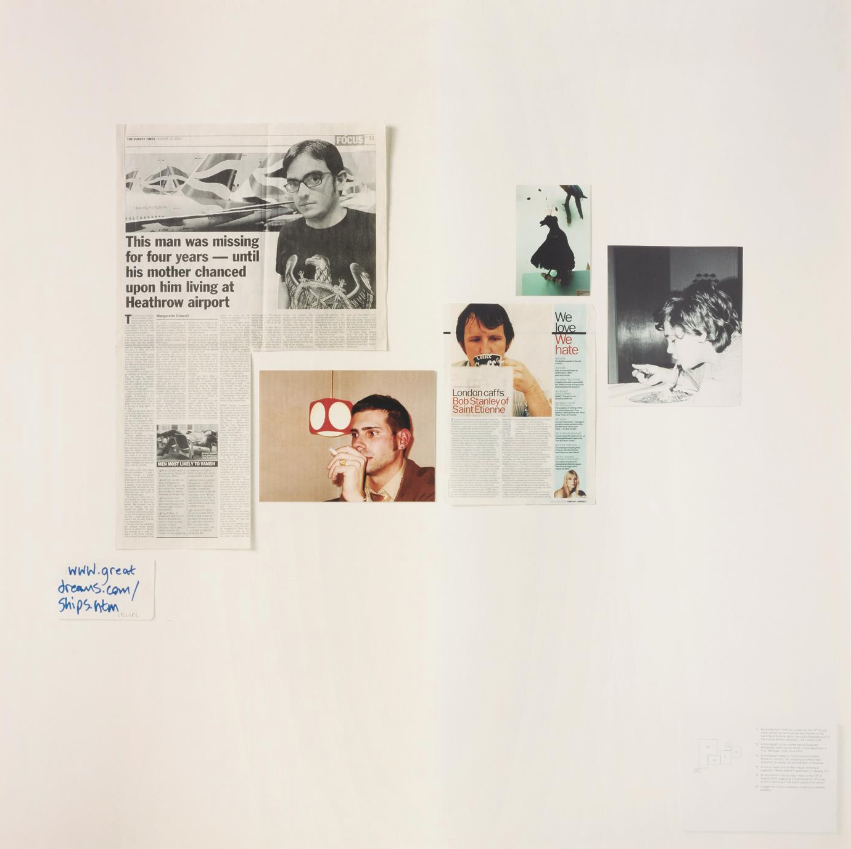
© » KADIST
Ryan Gander
Ryan Gander is a collector. He keeps all sorts of documents to create from. His studio is full of found images, personal images, documents copied from internet or cutout of newspapers.

© » KADIST
Martin Boyce
In the installation Our Love is like the Flowers, the Rain, the Sea and the Hours, Martin Boyce uses common elements from public gardens – trees, benches, trashbins– in a game which describes at once a social space and an abstract dream space. The trees, unique sources of light in the exhibition space, produce their own environment. These sculptures, as if extracted from a set, are enough to suggest an atmosphere, a landscape, or a movie.
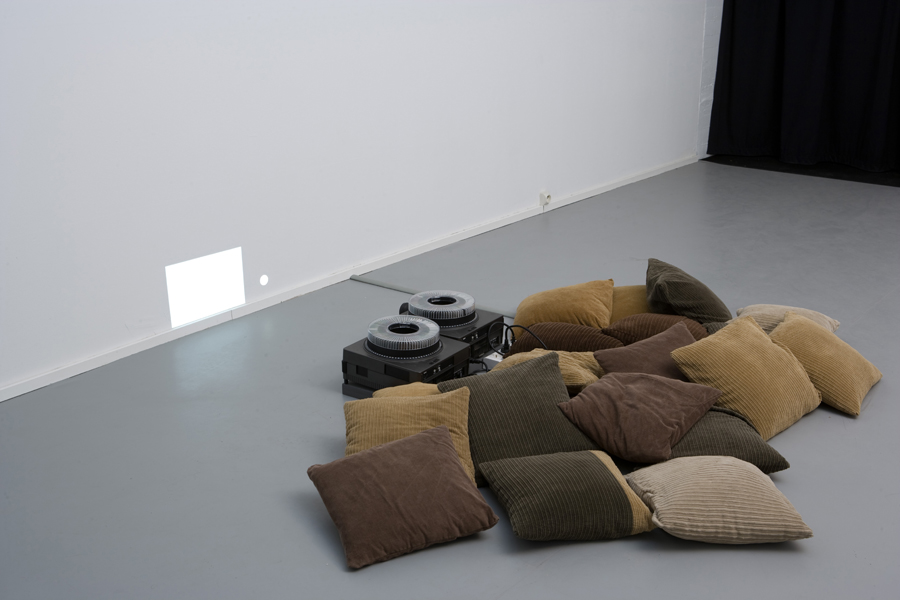
© » KADIST
Ryan Gander
This work is meditative and fragile. These abstract forms are projected slides belonging to another lecture, Travelogue , where the images have been removed. What is left is the hole of the frame of the slide that light draws upon and projects on the wall.
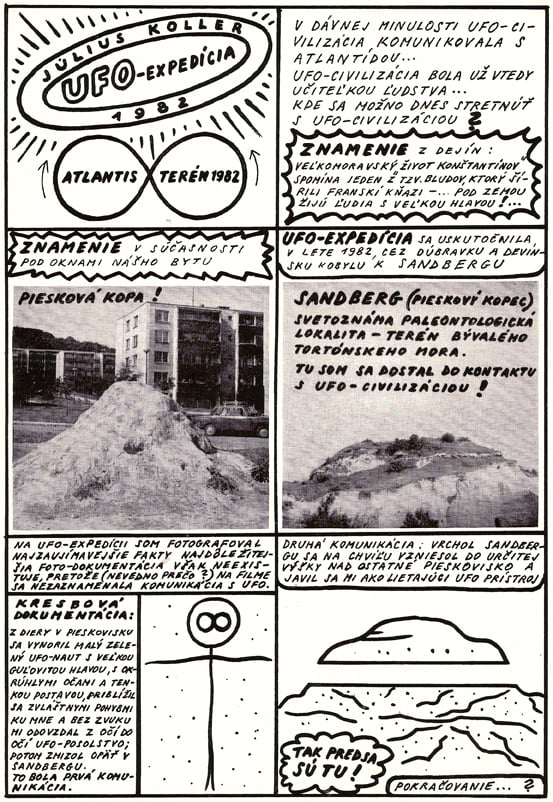
© » KADIST
Julius Koller
Drawing & Print (Drawing & Print)
Wordplay was a central focus of Koller’s work, in particular the acronym U. F. O., which he adapted in his diagrammatic drawings to stand variously for Univerzálna Futurologická Organizácia (Universal Futurological Organization, 1972–3), Univerzálny Filozoficky Ornament (Universal Philosophical Ornament, 1978) or Underground Fantastic Organization (1975), and which also appeared in a series of slapsticky self-portraits titled ‘U. F. O.–naut’ (1970–2007). These infinite variations on a common cipher constituted an insistent incantation of the Utopian principle.
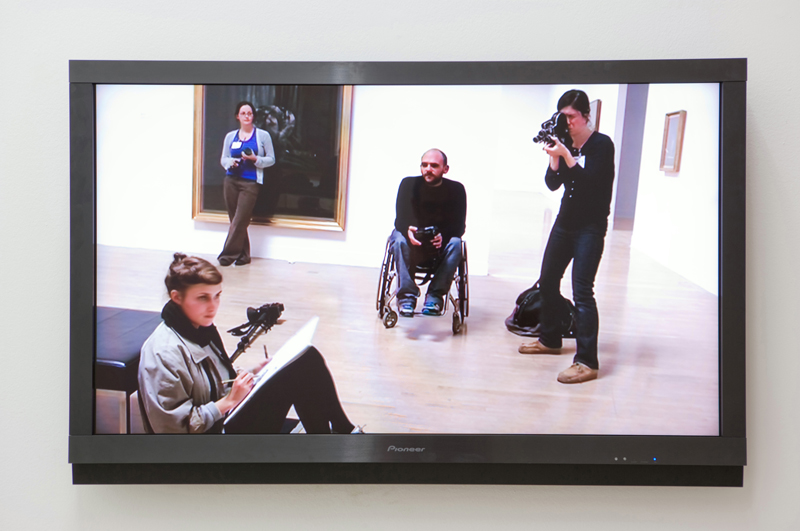
© » KADIST
Ryan Gander
The work consists of a work inside a work. The spectator is presented with a commissioned documentary on a flat-screen Tv on the subject of the production of the making of an artwork that doesn’t exist entitled The magic and the meaning (2008). The imaginary film, The magic and the meaning , is described only within the documentary, which follows parts of the making of the film, extracts from interviews with the writer and film maker Dan Fox and the artist and maker of the work Ryan Gander; as well as showing short slow-motion sections of the film that does not exist.

© » KADIST
Gregory Crewdson
Forest Gathering N.2 is part of the series of photographs Beneath the Roses (2003-2005) where anonymous townscapes, forest clearings and broad, desolate streets are revealed as sites of mystery and wonder; similarly, ostensibly banal interiors become the staging grounds for strange human scenarios. These scenes are tangibly atmospheric, visually alluring and often deeply disquieting. Never anchored precisely in time or place, these and the other narratives of Beneath the Roses are rather located in the dystopic landscape of the anxious American imagination.

© » KADIST
Jonathan Monk
Drawing & Print (Drawing & Print)
Meeting #100 is one in a series of text works by Jonathan Monk. In this series, the artist attempts to organize meetings somewhere in the world. The audience is given the details of a meeting—the place, date and time—and nothing more.
Ryan Gander
- location: Chester, United Kingdom
- year born: 1976
- gender: male
- nationality: British
Julius Koller
- location: Pieštany, Slovenská Republika
- year born: 1939
- gender: male
- nationality: Slovakian
Masaya Chiba
Masaya Chiba utilizes painting, sculpture, and installation to create dreamlike works that respond to Surrealism traditions while also exploring the limits of representation and translation...
Gregory Crewdson
- location: New York, New York
- year born: 1962
- gender: male
- nationality: American
- home town: Brooklyn, New York
Bobo
Bobo is an art collective constituting the artists Nick Payne, Andrew Gillespie, and Phil Cote, and while as a collective entity they are relatively new to the art world, they have been highly influential to many younger NY artists...
Jonathan Monk
- location: Berlin, Germany
- year born: 1969
- gender: male
- nationality: British
- home town: Leicester, United Kingdom
Nazgol Ansarinia
- location: Tehran, Îran
- year born: 1979
- gender: female
- nationality: Iranian
Goldin+Senneby
Since 2004, the artists Goldin+Senneby, comprised of Simon Goldin and Jakob Senneby, have been working on an ongoing performative and rhizomatic project...
Toby Ziegler
- location: London, United Kingdom
- year born: 1972
- gender: male
- nationality: British
Martin Boyce
- location: Hamilton, United Kingdom
- year born: 1967
- gender: male
- nationality: British
-
1980-1989
Julius Koller
Drawing & Print
1982(Drawing & Print) Wordplay was a central focus of Koller’s work, in particular the acronym U...
-
2000-2009
Martin Boyce
2003In the installation Our Love is like the Flowers, the Rain, the Sea and the Hours, Martin Boyce uses common elements from public gardens – trees, benches, trashbins– in a game which describes at once a social space and an abstract dream space...
Toby Ziegler
2005The Fifth Quarter might have taken its mysterious inspiration from the eponymous Stephen King story collated into the Nightmares & Dreamscapes collection...
Gregory Crewdson
2005Forest Gathering N.2 is part of the series of photographs Beneath the Roses (2003-2005) where anonymous townscapes, forest clearings and broad, desolate streets are revealed as sites of mystery and wonder; similarly, ostensibly banal interiors become the staging grounds for strange human scenarios...
Jazmín López
2008Shot on 35mm in two simply framed shots, Jazmín López’s Juego Vivo captures children at play, mixing imagination, reality, innocence, and violence...
-
2010-2019
Masaya Chiba
2011Fairy #2 (2011) depicts a surreal scene of roughly assembled household ephemera, potted plants, and a faintly visible figure rendered in thin red line...
Nazgol Ansarinia
2013In the early 2000s, as urban redevelopment accelerated and intense construction significantly diminished public space in Tehran, state-funded murals began to represent imaginary landscapes on building facades...



